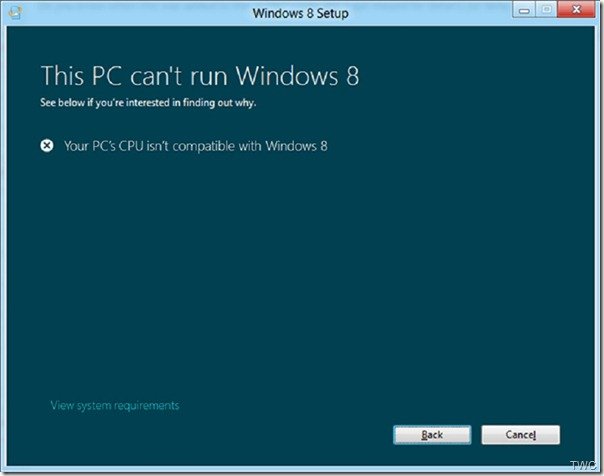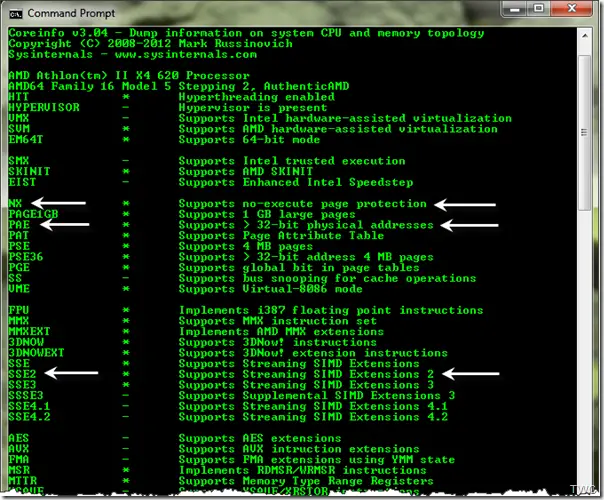Some people who are trying to install Windows 8 Release Preview are reporting an error. This error has been reported even by those who could run Windows 8 Consumer Preview on the same machine. While installing Windows 8 Release Preview , you may see the following error message:
Your PC’s CPU isn’t compatible with Windows 8
So what has changed since the Consumer Preview? Let us check what this error is and what Microsoft is saying about it.
As we can see, this error is related to CPU requirements for Windows 8 Release Preview. So to install Windows 8 RP, your CPU (processor) must support these features – PAE/NX/SSE2 .
Let us see what these means.
“No-eXecute (NX) is a processor feature that allows marking of memory pages as non-executable. The feature allows the CPU to help guard the system from attacks by malicious software. When the NX feature is enabled on a system, it prevents malicious software code from being placed in accessible regions of memory to be executed when control reaches that memory location. Windows 8 requires that systems must have processors that support NX, and NX must be turned on”
“Streaming SIMD Extensions 2 (SSE2) is a previous standard that is supported in Intel and AMD processors. All processors that support NX also support SSE2.”
“To use the NX processor feature, the processor must be running in Physical Address Extension (PAE) mode. PAE is a processor feature that enables x86 processors to access more than 4 GB of physical memory on capable versions of Windows. “
The processor requirement won’t impact customers on modern systems, or on systems that meet logo requirements for Windows 7 because these systems have PAE-capable 32-bit processors that support NX and allow NX to be turned on. Only a small set of customers who have Windows 7 running on very old 32-bit processors without PAE/NX support will be impacted.
Check if your system Supports NX or SSE2
To check this, there’s a Windows Sysinternals tool Coreinfo , a command-line utility. You can get it from here. Running this from the command line, will provide the required info - need to download coreinfo software.
A supported processor feature will have the * character displayed next to the feature name, and a - character if not supported.
“If PAE is displayed as not supported in Coreinfo output, your system has a processor that is not PAE-capable, and cannot support NX. If PAE is shown as supported, but NX is displayed as not supported in Coreinfo output:
· Consult the feature set published by the CPU manufacturer to determine if NX is supported by the processor on your system.
· If the processor on your system does have the NX support, then
your system may have misconfigured BIOS setting for NX support option.
If NX is supported on your system, can be turned on from BIOS settings if its not turned On.”
So check the BIOS and enable NX (“No eXecute bit”) or the equivalent
XD (“eXecute Disabled”) feature in the BIOS settings. Look them in
Advanced or Security options in BIOS. They may be referred by various
names according to BIOS manf. They can be named No Execute Memory
Protect, Execute Disabled Memory Protection, EDB (Execute Disabled Bit) ,
EVP (Enhanced Virus Protection) or by some oth name. So check for
these.
If the BIOS doesnt show any of these option for NX , then check with
BIOS manf for any BIOS updates which might have added this. Very old
processors may not include this feature.
Error 0×0000260
A related error is also seen in when trying to install Windows 8 in a VM with an error 0×0000260.
“If the Virtual Machine (VM) is hosted on a system that supports NX, you must enable PAE/NX in the virtualization product’s settings or configuration manager when setting up the Windows 8 virtual environment. “
For more detailed info on PAE/NX/SSE2 requirement for Windows 8, Microsoft has published a Whitepaper - PAE/NX/SSE2 Support Requirement Guide for Windows 8
This document details the processor support for the PAE/NX/SSE2 requirement in Windows 8, error cases and scenarios that customers encounter when machines fail to meet the requirement, and what to do to install Windows 8 on their PCs. The information provided in the document applies to Windows 8 and Windows Server 2012.
Microsoft’s Bill Fill explained in detail about this error in The
Answers Forum. He starts with apology for the inconvenience caused by
this issue and thanks the users for trying out the Release Preview.
Further he says that Microsoft may contact a few of those who reported
this issue if further info is needed as it may be a bug and has to be
corrected before RTM.
Then he describes what
exactly has changed since CP as users who could run the CP on their
machine encountered this issue while installing RP on the same machine.
What has changed in Windows 8 RP, since CP
We did make changes in the upgrade detection logic since the CP. The changes revolve around the default installer and how it checks for precise CPU features before continuing. Windows 8 requires the NX capabilities of modern CPUs. This is done for security reasons to ensure that malware defense features work reliably. This is important as we want to ensure that people can feel safe using lots of different software including desktop apps and apps from the Windows Store. This means some very old CPUs will not work with Windows 8. In the CP we did not block the installer for the NX feature. Based on CP telemetry we felt adding the block to setup was warranted to respect people’s time. It is better to get it over with quickly, even if it is disappointing.
We also used the telemetry to get some handle on how many CPUs would fail the NX requirement so we could be sure enforcing NX presence was responsible in the ecosystem. We learned that less than 1% of CPUs did not have NX capability available and configured correctly and out of those 0.1% did not have the NX capability at all. Based on this we feel that enforcing NX presence is a good thing to do since it results in better malware defenses. Thus we now enforce NX presence in the kernel boot sequence.
We didn’t make any change related to PAE detection, but it is good to note that PAE is a pre-requisite for NX on 32 bit processors due to how NX is implemented in memory manager page tables.
We did change SSE2 instruction set detection based on telemetry from the CP and Windows 7.
The result for users at large is their PC is more reliable. We do not check for SSE2 in the kernel boot sequence,;however, if your CPU has NX it also almost certainly has SSE2.
Workaround
Before trying this workaround, please check & configure NX in BIOS. The the workaround uses the ISO to install.
“Download the ISO and burn it to a DVD or create a bootable USB
flash drive. Boot from the media that you created. If your CPU does not
support NX you will see a code 5D bluescreen before setup starts. This
is rare, but if it happens we won’t be able to help you run Windows 8.
This workaround may succeed because Windows contains two
installers: the end user installer (setup.exe at the root of the Windows
DVD) and the commercial installer (setup.exe found in the \sources
directory of the Windows DVD). The commercial installer runs when the PC
is booted from DVD/USB media and does not perform the NX/SSE2 checks
and attempts to enable NX/SSE2 on supported systems.”
This issue has been explained in detail by Microsoft. If someone
getting this error, he or she can refer this and try the workaround.



 Windows
8 has been finalized and it is made available gradually through
different channels. For those who are new to
Windows
8 has been finalized and it is made available gradually through
different channels. For those who are new to 






































